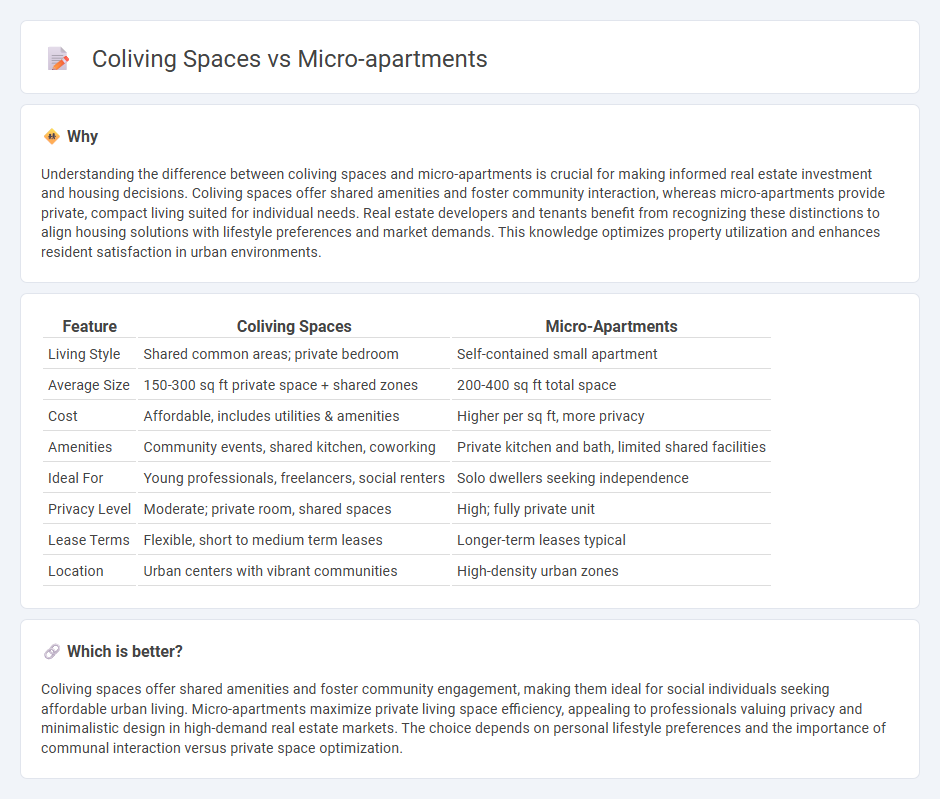
Coliving spaces foster community living with shared amenities and flexible leases, catering to young professionals and freelancers seeking affordability and social interaction. Micro-apartments maximize limited urban space through compact, efficiently designed units, appealing to individuals prioritizing privacy within city centers. Discover which innovative housing solution aligns best with your lifestyle and investment goals.
Why it is important
Understanding the difference between coliving spaces and micro-apartments is crucial for making informed real estate investment and housing decisions. Coliving spaces offer shared amenities and foster community interaction, whereas micro-apartments provide private, compact living suited for individual needs. Real estate developers and tenants benefit from recognizing these distinctions to align housing solutions with lifestyle preferences and market demands. This knowledge optimizes property utilization and enhances resident satisfaction in urban environments.
Comparison Table
| Feature | Coliving Spaces | Micro-Apartments |
|---|---|---|
| Living Style | Shared common areas; private bedroom | Self-contained small apartment |
| Average Size | 150-300 sq ft private space + shared zones | 200-400 sq ft total space |
| Cost | Affordable, includes utilities & amenities | Higher per sq ft, more privacy |
| Amenities | Community events, shared kitchen, coworking | Private kitchen and bath, limited shared facilities |
| Ideal For | Young professionals, freelancers, social renters | Solo dwellers seeking independence |
| Privacy Level | Moderate; private room, shared spaces | High; fully private unit |
| Lease Terms | Flexible, short to medium term leases | Longer-term leases typical |
| Location | Urban centers with vibrant communities | High-density urban zones |
Which is better?
Coliving spaces offer shared amenities and foster community engagement, making them ideal for social individuals seeking affordable urban living. Micro-apartments maximize private living space efficiency, appealing to professionals valuing privacy and minimalistic design in high-demand real estate markets. The choice depends on personal lifestyle preferences and the importance of communal interaction versus private space optimization.
Connection
Coliving spaces and micro-apartments both address urban housing affordability by maximizing limited square footage and offering communal amenities to enhance social interaction. These real estate models leverage innovative design and shared facilities to create cost-effective living environments in high-demand city areas. The integration of co-living principles within micro-apartment developments supports community building while optimizing space efficiency for young professionals and transient residents.
Key Terms
Shared amenities
Micro-apartments typically offer minimal shared amenities, focusing on compact private living spaces with basic communal areas such as laundry rooms or small lounges. Coliving spaces emphasize extensive shared amenities including fully equipped kitchens, coworking areas, fitness centers, and regular community events to foster social interaction. Explore our detailed comparison to find which living style best suits your shared amenities preference.
Private living units
Micro-apartments offer compact, self-contained private living units typically ranging from 200 to 400 square feet, featuring essential amenities such as mini-kitchens and private bathrooms, ensuring complete privacy and independence. Coliving spaces, while providing private bedrooms or studios, often share communal kitchens, lounges, and workspaces to foster community interaction, balancing privacy with social engagement. Explore more about how private living units vary in micro-apartments and coliving spaces to find the best fit for your lifestyle.
Community spaces
Micro-apartments provide compact private living areas with limited shared facilities, prioritizing personal space maximization within urban environments. Co-living spaces emphasize communal areas such as lounges, kitchens, and coworking zones designed to foster social interaction and collaboration among residents. Discover how these differing approaches impact community building and lifestyle choices in urban housing.
Source and External Links
Microapartment - Wikipedia - Microapartments are compact, self-contained one-room living spaces, typically ranging from 14-32 square meters, designed to efficiently combine sitting, sleeping, bathroom, and kitchenette areas, often with features like fold-down beds and hidden appliances to maximize space and are especially popular in dense urban areas worldwide.
Tiny apartments a big deal in many US cities | Multifamily Dive - Micro-apartments (under 441 sq ft) are increasingly common in new U.S. housing construction, driven by zoning reforms in cities like Seattle, Boston, and New York, as a response to affordability and density needs in urban centers.
Fashion Student's Cool Milan Micro Apartment, 21sqm/226sqft - This Milan micro-apartment (21 sqm/226 sqft) demonstrates innovative design solutions--such as layered zones, fold-out furniture, and a raised bed with walk-in storage--to create a light, functional, and visually spacious home within a minimal footprint.
 dowidth.com
dowidth.com